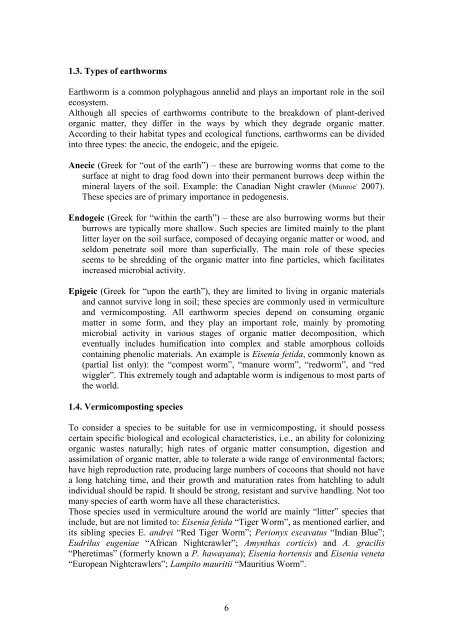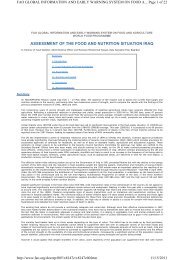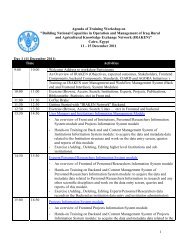Vermiculture in Egypt: - FAO - Regional Office for the Near East and
Vermiculture in Egypt: - FAO - Regional Office for the Near East and
Vermiculture in Egypt: - FAO - Regional Office for the Near East and
You also want an ePaper? Increase the reach of your titles
YUMPU automatically turns print PDFs into web optimized ePapers that Google loves.
1.3. Types of earthworms<br />
Earthworm is a common polyphagous annelid <strong>and</strong> plays an important role <strong>in</strong> <strong>the</strong> soil<br />
ecosystem.<br />
Although all species of earthworms contribute to <strong>the</strong> breakdown of plant-derived<br />
organic matter, <strong>the</strong>y differ <strong>in</strong> <strong>the</strong> ways by which <strong>the</strong>y degrade organic matter.<br />
Accord<strong>in</strong>g to <strong>the</strong>ir habitat types <strong>and</strong> ecological functions, earthworms can be divided<br />
<strong>in</strong>to three types: <strong>the</strong> anecic, <strong>the</strong> endogeic, <strong>and</strong> <strong>the</strong> epigeic.<br />
Anecic (Greek <strong>for</strong> “out of <strong>the</strong> earth”) – <strong>the</strong>se are burrow<strong>in</strong>g worms that come to <strong>the</strong><br />
surface at night to drag food down <strong>in</strong>to <strong>the</strong>ir permanent burrows deep with<strong>in</strong> <strong>the</strong><br />
m<strong>in</strong>eral layers of <strong>the</strong> soil. Example: <strong>the</strong> Canadian Night crawler (Munroe , 2007).<br />
These species are of primary importance <strong>in</strong> pedogenesis.<br />
Endogeic (Greek <strong>for</strong> “with<strong>in</strong> <strong>the</strong> earth”) – <strong>the</strong>se are also burrow<strong>in</strong>g worms but <strong>the</strong>ir<br />
burrows are typically more shallow. Such species are limited ma<strong>in</strong>ly to <strong>the</strong> plant<br />
litter layer on <strong>the</strong> soil surface, composed of decay<strong>in</strong>g organic matter or wood, <strong>and</strong><br />
seldom penetrate soil more than superficially. The ma<strong>in</strong> role of <strong>the</strong>se species<br />
seems to be shredd<strong>in</strong>g of <strong>the</strong> organic matter <strong>in</strong>to f<strong>in</strong>e particles, which facilitates<br />
<strong>in</strong>creased microbial activity.<br />
Epigeic (Greek <strong>for</strong> “upon <strong>the</strong> earth”), <strong>the</strong>y are limited to liv<strong>in</strong>g <strong>in</strong> organic materials<br />
<strong>and</strong> cannot survive long <strong>in</strong> soil; <strong>the</strong>se species are commonly used <strong>in</strong> vermiculture<br />
<strong>and</strong> vermicompost<strong>in</strong>g. All earthworm species depend on consum<strong>in</strong>g organic<br />
matter <strong>in</strong> some <strong>for</strong>m, <strong>and</strong> <strong>the</strong>y play an important role, ma<strong>in</strong>ly by promot<strong>in</strong>g<br />
microbial activity <strong>in</strong> various stages of organic matter decomposition, which<br />
eventually <strong>in</strong>cludes humification <strong>in</strong>to complex <strong>and</strong> stable amorphous colloids<br />
conta<strong>in</strong><strong>in</strong>g phenolic materials. An example is Eisenia fetida, commonly known as<br />
(partial list only): <strong>the</strong> “compost worm”, “manure worm”, “redworm”, <strong>and</strong> “red<br />
wiggler”. This extremely tough <strong>and</strong> adaptable worm is <strong>in</strong>digenous to most parts of<br />
<strong>the</strong> world.<br />
1.4. Vermicompost<strong>in</strong>g species<br />
To consider a species to be suitable <strong>for</strong> use <strong>in</strong> vermicompost<strong>in</strong>g, it should possess<br />
certa<strong>in</strong> specific biological <strong>and</strong> ecological characteristics, i.e., an ability <strong>for</strong> coloniz<strong>in</strong>g<br />
organic wastes naturally; high rates of organic matter consumption, digestion <strong>and</strong><br />
assimilation of organic matter, able to tolerate a wide range of environmental factors;<br />
have high reproduction rate, produc<strong>in</strong>g large numbers of cocoons that should not have<br />
a long hatch<strong>in</strong>g time, <strong>and</strong> <strong>the</strong>ir growth <strong>and</strong> maturation rates from hatchl<strong>in</strong>g to adult<br />
<strong>in</strong>dividual should be rapid. It should be strong, resistant <strong>and</strong> survive h<strong>and</strong>l<strong>in</strong>g. Not too<br />
many species of earth worm have all <strong>the</strong>se characteristics.<br />
Those species used <strong>in</strong> vermiculture around <strong>the</strong> world are ma<strong>in</strong>ly “litter” species that<br />
<strong>in</strong>clude, but are not limited to: Eisenia fetida “Tiger Worm”, as mentioned earlier, <strong>and</strong><br />
its sibl<strong>in</strong>g species E. <strong>and</strong>rei “Red Tiger Worm”; Perionyx excavatus “Indian Blue”;<br />
Eudrilus eugeniae “African Nightcrawler”; Amynthas corticis) <strong>and</strong> A. gracilis<br />
“Pheretimas” (<strong>for</strong>merly known a P. hawayana); Eisenia hortensis <strong>and</strong> Eisenia veneta<br />
“European Nightcrawlers”; Lampito mauritii “Mauritius Worm”.<br />
6





